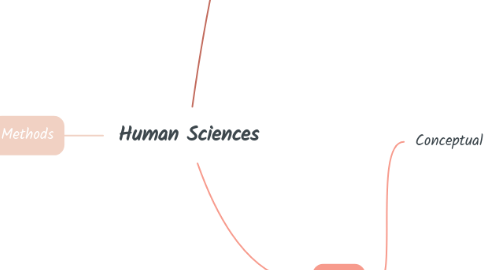
1. Methods
1.1. Surveys & Questionnaires
1.1.1. A method of gathering information from a sample of people using a standardised set of questions
1.1.1.1. Strengths: Quick information; useful for gauging public opinions, behaviors, or attitudes.
1.1.1.2. Weaknesses: Easily biased, depends on honest self-reporting
1.1.2. • Explanation: A method of gathering information from a sample of people using a standardized set of questions. • Strength/Utility: Can gather a large amount of data quickly; useful for gauging public opinions, behaviors, or attitudes. • Limitations: Can be affected by biases (e.g., response bias, selection bias); depends on honest self-reporting. • Example: Psychologists use surveys to assess societal attitudes towards mental health.
1.2. Experiments (Laboratory & Field)
1.2.1. A controlled study with manipulated variables to measure the effects on a particular outcome
1.2.1.1. Strengths: Control over variables, establishing casualties
1.2.1.2. Weaknesses: Lack of ecological validity, may not generalize to real world settings
1.3. Longitudinal Studies
1.3.1. Research that follows and collects data from the same subjects over an extended period
1.3.1.1. Strengths: Observing changes over time, allows identification of patterns and trends
1.3.1.2. Weaknesses: Time consuming, potential drop out rates and cost effective
1.4. Ethnography
1.4.1. A research method where the investigator studies a culture or social group by immersing themselves in it
1.4.1.1. Strengths: In depth understanding of cultures and practices
1.4.1.2. Weaknesses: Time intensive, subjective, findings may not generalize
1.5. Case Studies
1.5.1. An in-depth exploration of a specific instance, event, or individual to derive broader insights
1.5.1.1. Strengths: Detailed analysis of particular context
1.5.1.2. Weaknesses: Can be subjective with a limited generalizability
1.6. Statistical Analysis
1.6.1. Applying mathematical and statistical techniques to analyze and interpret data
1.6.1.1. Strengths: Requires accurate data collection; correlation doesn’t imply causation
1.7. Naturalistic Observation
1.7.1. Observing subjects in their natural environment without any interference
1.7.1.1. Strengths: High ecological validity; captures real-world behavior
1.7.1.2. Weaknesses: Observer bias; lack of control over external variables
1.8. Qualitative Interviews
1.8.1. One-on-one interviews aiming to gather detailed and nuanced information from the respondent
1.8.1.1. Strengths: Extracts deep, personal insights
1.8.1.2. Weaknesses: Time consuming; subject to interviewer biases
1.9. Modelling
1.9.1. Creating abstract representations of a system to simulate and understand complex real-world scenarios
1.9.1.1. Strengths: Simplifies complex scenarios, predicts future trends or outcomes
1.9.1.2. Weaknesses: Can oversimplify realities
1.10. Meta - Analysis
1.10.1. A statistical method that combines the results of multiple studies to identify common findings or trends
1.10.1.1. Strengths: Increases statistical power; offers comprehensive insights
1.10.1.2. Weaknesses: Publication bias
2. Scope
2.1. Anthropology
2.1.1. The study of human cultures, societies, and their development
2.2. Sociology
2.2.1. The study of human society, social relationships, and social structures
2.2.1.1. Social Work
2.2.1.1.1. individual and societal well-being
2.3. Psychology
2.3.1. The mind and behavior, including cognitive processes, emotions, and social interactions
2.3.1.1. Criminology
2.3.1.1.1. crime causation and prevention
2.4. Economics
2.4.1. The study of the production, distribution, and consumption of goods and services, as well as the behavior of individuals and organizations in the market
2.4.1.1. Political Science
2.4.1.1.1. The study of political systems, institutions, and behavior
2.5. Geography
2.5.1. The study of the Earth's physical features, climate, and human populations, including their spatial distribution and interactions
2.5.1.1. History
2.5.1.1.1. The study of past events, societies, and individuals, often focusing on the interpretation and analysis of written records and other sources of evidence
2.6. Education
2.6.1. learning methodologies
2.6.1.1. Linguistics
2.6.1.1.1. The study of language, including its structure, history, and social context
3. Tools
3.1. Conceptual tools
3.1.1. Theories & models
3.1.1.1. Abstract frameworks simplifying complex realities, with predictive capabilities
3.1.1.1.1. Psychology employs Maslow's Hierarchy of Needs, while economics utilises the Supply-Demand model
3.1.2. Hypotheses
3.1.2.1. Testable statements guiding research
3.1.2.1.1. A psychologist might posit a connection between adolescent screen time and sleep quality
3.1.3. Conceptual frameworks
3.1.3.1. Structured approaches to phenomena, defining relevant concepts and their interrelationships
3.1.3.1.1. Sociology's "cultural capital" examines non-financial assets that foster social mobility
3.1.4. Paradigms
3.1.4.1. Dominant scientific community perspectives influencing data interpretation
3.1.4.2. Dominant scientific community perspectives influencing data interpretation
3.1.5. Conceptual metaphors
3.1.5.1. Bridge the gap between known and unknown concepts, offering insights
3.1.5.1.1. Adam Smith's "invisible hand" in economics illustrates this, denoting unintended societal benefits from individual actions
3.1.6. Heuristics
3.1.6.1. Mental shortcuts, facilitate decision-making. However, they might introduce biases
3.1.6.1.1. Behavioral economics' "availability heuristic" underscores how people might overvalue readily available information, typically due to its recency
3.1.7. Dominant scientific community perspectives influencing data interpretation
3.2. Practical tools
3.2.1. Statistical software
3.2.1.1. A digital space for quantitative data analysis
3.2.1.1.1. Tools like SPSS, R, and Stata are staples in various disciplines
3.2.2. Data collection instruments
3.2.2.1. Gather primary data
3.2.2.1.1. Range from paper-based methods to advanced digital tools, like eye-tracking devices in psychological experiments
3.2.3. Archives & databases
3.2.3.1. Store historical records and datasets
3.2.3.1.1. Researchers might turn to JSTOR for academic papers or the World Bank's database for economic insights
3.2.4. Digital research platforms
3.2.4.1. Streamline research, aiding in everything from data collection to collaboration
3.2.4.1.1. Survey platforms like Qualtrics or collaborative spaces like ResearchGate
3.2.5. Coding & thematic analysis tools
3.2.5.1. Dissect qualitative data, highlighting patterns
3.2.5.1.1. NVivo, for instance, aids in coding textual data
3.2.6. Visualisation tools
3.2.6.1. Transform intricate data into comprehensible visual formats
3.2.6.1.1. Tableau or even Microsoft Excel's graphing capabilities are often employed to this end
